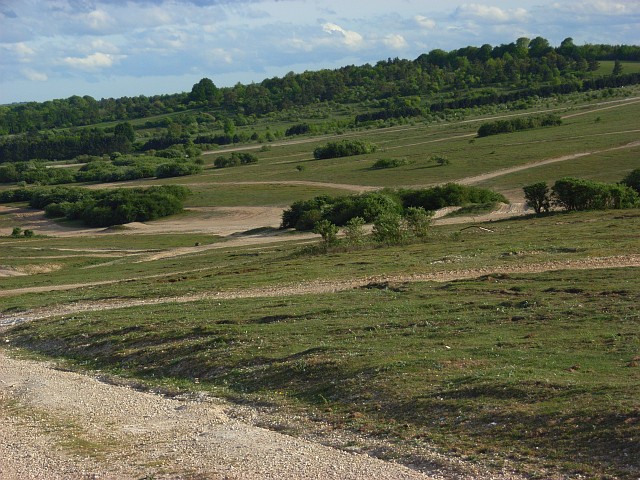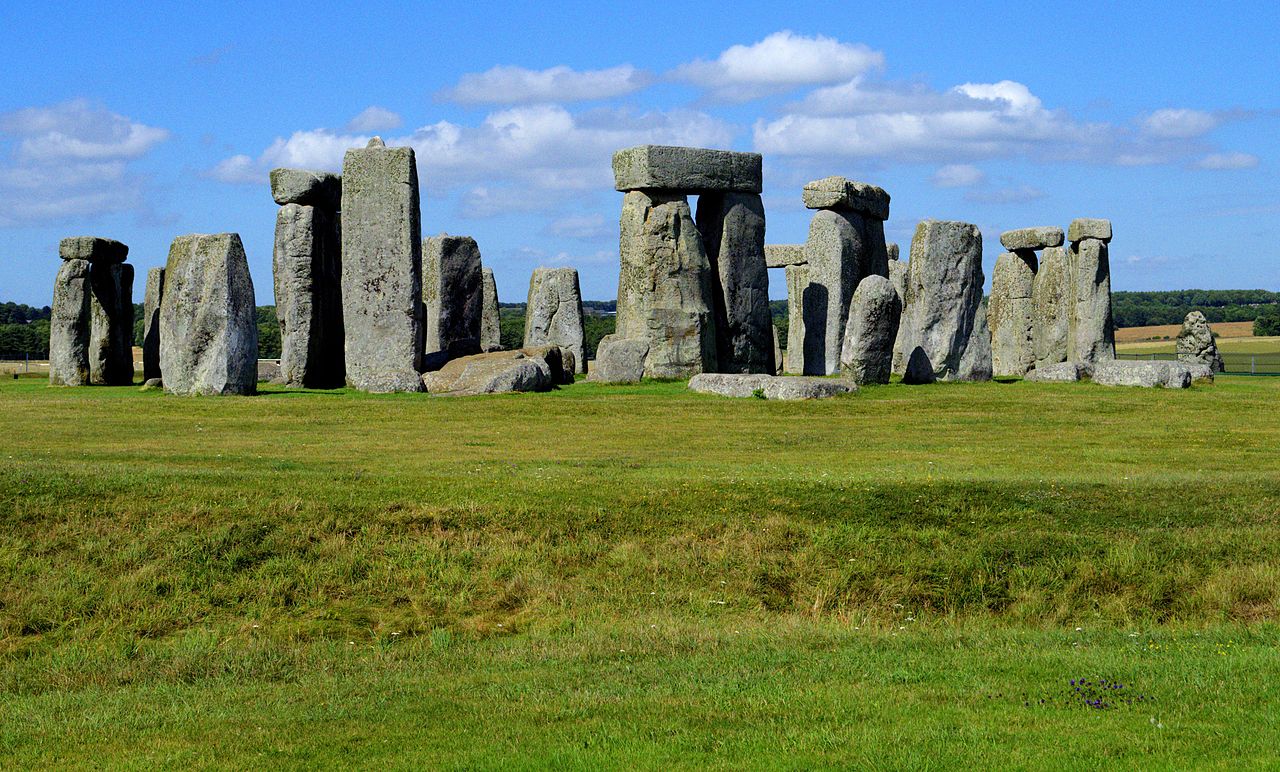
Steve Jones has worked in conservation in the UK and overseas for two decades, promoting wildlife-friendly farming and designated site conservation in the UK, and large mammal conservation in the tropics. He writes on wildlife-friendly farming, land sparing and rewilding at https://naturalareasblog.wordpress.com
Making space for wild nature in England’s wheat belt
Rewilding advocates searching the UK for places to host a pilot or two are unlikely to settle long upon the endless wheat deserts of Wiltshire. Indeed, advocates of land sparing will probably look at Wiltshire as the sort of place where very high-yield farming should continue, to allow land to be spared for nature elsewhere.
But examine central Wiltshire in Google Earth and one is struck by the existence of an extensive landscape of relatively flat grassy plains, sitting directly north of Stonehenge and the A303. Here, in one of southern England’s most productive arable landscapes, is one of the north-west Europe’s earliest, largest, inadvertent rewilding areas.

The hidden 28,000 hectares
At around 28,000ha, the core chalk grassland plains of the Salisbury Plain Training Area (SPTA) are the largest ‘surviving’, intact example of this habitat anywhere. ‘Surviving’ is probably not the correct term, because a fair proportion of what is now a large military training area has been cultivated in the past, only reverting to grassland upon acquisition by the state. The MoD continue to revert arable to grassland here, and parts of the adjacent Stonehenge World Heritage Site (WHS) are the subject of more recent arable reversion.
The first phase of rewilding on a grand scale?
If one includes the publicly-owned arable bordering the SPTA grassland, the nearby Porton Down, and the parts of the WHS in conservation ownership, we find around 40,000 hectares (400 square kilometres) of land potentially available for trophic rewilding.
Essentially, the first stage of inadvertent rewilding has already taken place, partly to protect sub-surface archaeological remains and create a more sympathetic setting for Stonehenge, and partly to serve the current needs of the military.
Not surprisingly, SPTA has retained extraordinary biodiversity value, and part of its value is the product of its sheer scale, and of disturbance. Parts of what is now SPTA and the WHS have never been ploughed, and these old chalk grassland patches have provided a source of plants and animals to colonise areas reverted from arable. This process of grassland habitat defragmentation, consolidation and enlargement is on-going with the potential for even more grassland creation on publicly-owned arable controlled by the MoD.
Metallic-megafauna
Military training with a metallic-megafauna of tanks currently creates and maintains a patchy disturbance regime upon which so much biodiversity depends. Tanks churn the chalky substrate, creating germination patches for ‘arable’ flora and parched crumbly soil for invertebrates. Tank-track puddles support a thriving fairy shrimp population. The impact area has frequent fires, whilst very light, rotational grazing by domestic stock maintain a mosaic of sward heights and densities. This mix of metallic, pyric and domestic herbivory and disturbance greatly influences the patterns of settlement by ground-nesters like skylarks, patchy marsh fritillary distributions and patterns of species-rich chalk scrub expansion and recession.
Bringing back the aurochs
So, we have here something that’s quite difficult to achieve in the English lowlands – habitat at scale. Can we foresee a future in which, as one alights to view Stonehenge, one is also treated to the spectacle of a landscape rich in wild megafauna?

Imagine the ecotourism potential here! People drive from all across the country – and fly from across the world – to see Stonehenge. Imagine the added attraction of hikes across rewilded plains full of grazing and browsing megafauna and, if we can modestly increase the extent of chalk scrub and copses, their predators too. If we can accommodate domestic cattle at Stonehenge and the huge training area to the north, why not their wilder counterparts?
What sorts of wild megafauna might be appropriate? The status of European bison in the UK is passionately contested, and the European wild horse and aurochs are, of course, extinct. Efforts are being made to back-breed into extant cattle the traits which were assumed to characterise wild aurochs. Of course, we can’t know the precise ecological traits of aurochs, but we can make well-informed inferences, and groups are doing just that. We will very likely soon have available animals that are, ecologically, very much more like aurochs than the domestic ‘rare and hardy breeds’ we currently use for grazing conservation landscaped, including those at Stonehenge and on the Salisbury Plain Training Area and Porton Down. If we’re happy using domestic livestock, and celebrate the ecological benefits of metallic-megafauna (tanks), how could we logically object to things back-bred to behave more like aurochs? The same with horses: why would rewilded feral horses behaving much like their wild ancestors be so objectionable to anyone (other than the MoD!)?
Some argue in favour of Pleistocene rewilding – introducing what they assume to be wild ecological surrogates for extinct species like elephants and rhinos. I’ll leave that open, saying merely that it needs a lot more thought and debate, and it’s not something I’d advocate.
But what about the ecological risks? Surely the core chalk grasslands of SPTA are of substantial biodiversity value which could be damaged by a revved-up rewilding programme?
Well, yes, the SPTA core grassland is a SAC and SSSI, and this and a larger arable area is also an SPA and SSSI. But the SAC value is really a function of the fact that it’s massive and open, and its ecology is largely driven by disturbance and patch dynamics – it’s not the sort of place where the precise ecological attributes of every square metre can be usefully defined. I’d argue that the careful reintroduction of wild and wild-type megafauna will not adversely alter the ecology of the area. How about the SPA? Well, stone curlews are a key interest here, and much of the population nests on specially cultivated plots in grassland and arable, or other heavily disturbed areas, with adult birds foraging for food on the bare ground of tank tracks and tilled areas – much of the grassland is too tall in summer for feeding stone curlews. The mosaic of sward heights created by mixed grazing and browsing herbivores – aurochs and wild horse surrogates breaking up scrubby areas and thick upright brome swards and creating grazing lawns – could well benefit stone curlews. And where tanks create water-filled ruts and churned pits of loose soil, could aurochs create water-filled wallows and sandy bathing pits? Tanks plough through scrubby patches, just as aurochs surely once did.
More specifically – where to start?
Notwithstanding the need to protect archaeological remains, it’s not unreasonable to say that the Stonehenge World Heritage Site area north of the A303 is already available for megafauna reintroductions. This could be the first phase. One would then need to negotiate with the MoD to revert arable land between this NT-owned area and The Packway, the road dividing the WHS from the larger SPTA. This MoD arable is public land, all-be-it leased to tenants. Incorporation to create a grassy corridor to SPTA is therefore feasible. But what of The Packway itself? It’s not a particularly busy road: one could foresee a mix of cattle grids and traffic calming, creating a megafauna crossing stretch along say 100 m of the carriageway. Of course, any other State would fund a wildlife tunnel or green bridge. This would give megafauna access to a relatively quiet part of southern SPTA west of Larkfield. If even a small area of MoD grassland here is opened-up for megafauna – say 4 square kilometres – it would be a start.
The big constraint here is not land ownership – much of the 400 square kilometres is publicly owned; it’s not human population density – the core 28,000 ha is of course unoccupied; it’s not existing ecological value – wild herbivores and their predators would compliment existing drivers of biodiversity value here; it’s not cost, notwithstanding some infrastructure tweaks and arable reversion. The real constraint upon the bigger part of the area is of course current use for military training. Carefully managed domestic stock are completely different beasts to free-ranging herds of essentially wild cattle and horses. Could such populations be managed so as not to pose an insurmountable constraint on military training requirements?
If the government and others were to be persuaded to consider accommodating relatively free-ranging herds of wild bovids and equids at Stonehenge and parts of SPTA, we’d have the core of an impressive rewilding project in southern England, through which passes a major transport corridor, and at the core of which already exists the major global tourist attraction of Stonehenge.
[registration_form]
A great start would be to get this ‘article’ into Sanctuary – the MOD conservation magazine. There would be huge support from inside the Defence Infrastructure Organisation (DIO).
Roger – thank you and Welcome!
Thanks Roger – presumably contact details are online somewhere. I’ll investigate.
Great guest blog and an area where, 60 years ago as a rookie birdwatcher, I saw and, quite as importantly, heard my first stone curlews in flocks up to 30 strong. The memory lingers with me through all the intervening years…..enhanced by recent trips across the many rough tracks that crisscross the plain and to the Great Bustard project, where stone curlews can be seen.
The potential is enormous, maybe Rewilding Britain, the Great Bustard Project, the Wilts WT, NT and RSPB, working together, could be encouraged to take these ideas forward with the MOD?
Porton Down has a fantastic range of invertebrates and plants and would provide a key core area and source from which these groups could spread. There is potential for exciting raptors to really establish themselves (naming no names) and of course the magnificent great bustards would be a huge draw.
And perhaps the now sadly defunct Great Bustard Inn which stands empty in the middle of the plain could have a new lease of life.
Nick
Sorry to hear the Great Bustard Inn is now defunct – I recall productive meetings in that fine pub with reps of the groups you mention, followed by strolls out across wonderful open grassy plains that stretch to all horizons! I’m sure such a perfectly-placed pub could draw crowds with intelligent marketing, without adverse effects in military training. Maybe scattered grazing lawns would draw in lekking bustards?! And wouldn’t it be great to link up SPTA east with Porton Down – a grand sweep of calcareous grassland and ‘extensive’ cereals linking Porton, SPTA east and Centre, right down to Stonehenge.
The Great Bustard Inn is not empty but is now run as an outdoor therapy centre by a charity.
Lots of good ideas here from Steve & commentators but I can’t see the MoD getting on board anytime soon. Also there was no mention of the 4,700 soldiers and their families which are being relocated around Salisbury Plain by 2020 and the massive infrastructure, including over 900 houses, which is being built to support them. Plus lots of non-military house building in Amesbury and surrounding areas and also building at Porton Down with the new Science Park there.
It’s proving difficult protecting what we’ve currently got in Wiltshire, let alone trying to rewild the area sadly.
Farming UK seems concerned that “Elephant-sized Nazi super-cows could be revived by scientists in the future”. What the Heck!!!
Didn’t Derek Gow have to cull half of his herd in order to protect his colleagues?! I suppose they probably are the closest breed to Auroch we have. They don’t look very scary to me – just a bit a bit like a curly coated unkempt Brown Swiss.
Yes you are right Ernest. Derek Gow had a herd of Heck cattle at his Devon farm. Heck cattle were a breed created by the Nazi’s who tried to recreate the wild auroch breed. He had to get rid of them because they were too aggressive for him to have on his farm. They were a danger to farm workers and visitors and hard to handle and move around. See more here: https://www.theguardian.com/world/2015/jan/05/devon-farmer-forced-offload-nazi-bred-super-cows
If Derek Gow was the chap with the Hecks, article in Farming UK says he culled them because they kept trying to cull him. The headline has been changed to “Elephant-sized auroch cow …” but the references to Nazis and Adolf Hitler still remain. As does the original title in the feed list. No doubt someone was forced to take to Twatface to express their outrage and crash the internet.
Lovely blog and ideas – thanks Steve.
Who came up the ‘metallic-megafauna’ tag?
Brilliant.
Speaking metaphorically (and megafaunally), tanks need to be put on everyone’s lawn, especially those lovely deep green, Grade 4/5, ex-heathland lowland pastures. They have huge carbon footprints and are ecological deserts. Let some of them be exploited for the building industry and then abandoned to become inverted terrestrial reefs amidst the surrounding seas of grass, wheat, corn and rape monocultures.
Afterwards, there’s only one group of people that should be excluded from post-industrial quarries – that’s planners and landscape architects with their prettifying and gardening ideas.
The best and wildest abandoned pits are the forgotten ones, the ones with plenty of edge and edge effect. It is these self-willed sites that are great at producing tales of the unexpected – mini-Serengetis if you like.
Here’s a pic of a recently extinct metallic megafauna, Ruston Bucyrus. It did a good job while it was alive and has left a wonderful unplanned and evolving legacy.
http://www.friendsofmidhurstcommon.co.uk/wp-content/uploads/2015/04/25-10-2014-162139.jpg
Excellent.
An appropriate blog on the day that the government announced the tunneling of the A303 at Stonehenge. My concern Steve is that to someone not aware of Wiltshire you may be giving an inaccurate impression of what the county consists of.
Very much a chalk and cheese county the downlands only occur in the southern or eastern part and even then are not the flat wheat deserts that might be portrayed here. Very much split up by river valleys, roads and winterbournes. It is publicly owned but a lot of it seized from old landowners to support war time training and their descendants may want it back with wild horses not dragging them away from that feeling.
The SPTA is a training area but people should not get the impression of soldiers marching up and down shouting at each other. There are real bullets over most of it, real bombs, helicopter and parachute landing zones and any birder should be fully aware that he/she is potentially being watched by someone wearing camouflage and a hard hat covered in ferns.
I can’t disagree with any attempt to re-wild parts of the plain but surely this area, that I know as the Fargo area, has to be a non starter. Put the A303 tunnel in which opens up the landscape and fences would be needed to keep your aurochs from invading Amesbury and thus totally destroying the concept of open vistas. The Fargo area is not really used by the MOD so on balance it looks suitable but it also sits right in the area that is increasingly yielding important archaeological surprises. In the future Stonehenge could easily become of lesser importance compared to some of the archaeology being discovered in this area.
Across the packway on the Larkhill ranges there are a few not well known byways but don’t park the car or tie up your aurochs when there’s a tank coming.
Good concept Steve but one that probably needs a lot of thought and a better location. SPTA is a large area that should accommodate such a proposal but finding the right location might be a fight of its own.
Yes the real gains are to be made south of SPTA. Use the new road as a catalyst to join the landscape from the Avon to the Wylye using Stonehenge, Parsonage Down and Yarnbury Castle as stepping stones.
Introduce wild horses and Heck cattle? And how are these going to be controlled? By wolves or the army? Sorry, but this is a nonsense for Wiltshire.
Hi Sandra. I didn’t mention Heck cattle. You’re assuming (maybe with good reason) that aurochs were ‘controlled’ by wolves. I’m not so sure: would wolves not have focused on larger deer? Aurochs were bloody huge! They (presumably) formed herds. Extinct wild cattle defend their offspring from predators. Maybe aurochs numbers were not regulated by top-down-down processes (i.e. predation) but were rather bottom-up regulated by food availability? I’ll ask some ungulate ecologists and probably write further about this. Either way, given that people regulate the numbers of domestic stock at Stonehenge and on Salisbury Plain, I’m not entirely convinced it would devalue the exercise if we acted to manage the populations of their ecological surrogates, especially if, in return, nature benefited from the various functional and structural things delivered by massive, wild-type cattle that hopeless domesticated forms just cannot provide. The MoD might not agree, though. And why not the 40,000ha even if they happen to be in Wiltshire?